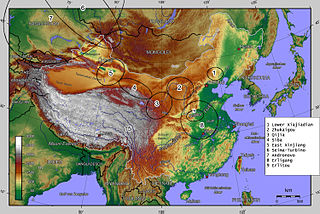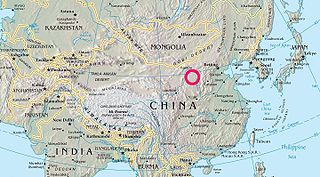 W
WThe Afanasievo culture, or Afanasevo culture, is the earliest known archaeological culture of south Siberia, occupying the Minusinsk Basin and the Altai Mountains during the eneolithic era, c. 3300 to 2500 BCE. It is named after a nearby mountain, Gora Afanasieva in what is now Bogradsky District, Khakassia, Russia.
 W
WBeifudi is an archaeological site and Neolithic village in Yi County, Hebei, China. The site, an area of 3 ha on the northern bank of the Yishui River, contains artifacts of a culture contemporaneous with the Cishan and Xinglongwa cultures of about 8000–7000 BP, two known Neolithic cultures east of the Taihang Mountains, and thus fills an archaeological gap between the two Northern Chinese cultures. The total excavated area is more than 1,200 square meters and the collection of neolithic findings at the site has been conducted in two phases.
 W
WThe Erligang culture is a Bronze Age urban civilization and archaeological culture in China that existed from approximately 1510 to 1460 BC. The primary site, Zhengzhou Shang City, was discovered at Erligang, within the modern city of Zhengzhou, Henan, in 1951.
 W
WThe Erlitou culture was an early Bronze Age urban society and archaeological culture that existed in the Yellow River valley from approximately 1900 to 1500 BC. A 2007 study of radiocarbon dating proposed a narrower date range of 1750 to 1530 BC. The culture was named after the site discovered at Erlitou in Yanshi, Henan. The culture was widely spread throughout Henan and Shanxi and later appeared in Shaanxi and Hubei. Chinese archaeologists generally identify the Erlitou culture as the site of the Xia dynasty, but there is no firm evidence, such as writing, to substantiate such a linkage.
 W
WThe Feijiahe culture, also known as Zhangshutan-Feijiahe culture or Duimenshan-Feijiahe, is a Bronze Age archaeological culture in China. It has been commonly dated to approximately 1300 to 1000 BC. Centered in the area east of Dongting Lake, the Feijiahe culture was a post-Erligang culture marked by the increase of localized traditions.
 W
WLoulan, also called Krorän or Kroraina, was an ancient kingdom based around an important oasis city along the Silk Road already known in the 2nd century BCE on the northeastern edge of the Lop Desert. The term Loulan is the Chinese transcription of the native name Krorän and is used to refer to the city near Lop Nur as well as the kingdom.
 W
WThe Lower Xiajiadian culture is an archaeological culture in Northeast China, found mainly in southeastern Inner Mongolia, northern Hebei and western Liaoning, China. Subsistence was based on millet farming supplemented with animal husbandry and hunting. Archaeological sites have yielded the remains of pigs, dogs, sheep and cattle. The culture built permanent settlements and achieved relatively high population densities. The population levels reached by the Lower Xiajiadian culture in the Chifeng region would not be matched until the Liao Dynasty. The culture was preceded by the Hongshan culture, through the transitional Xiaoheyan culture. The type site is represented by the lower layer at Xiajiadian, Chifeng, Inner Mongolia.
 W
WThe Ordos culture was a culture occupying a region centered on the Ordos Loop during the Bronze and early Iron Age from the 6th to 2nd centuries BCE. The Ordos culture is known for significant finds of Scythian art and is thought to represent the easternmost extension of Indo-European Eurasian nomads, such as the Saka. Under the Qin and Han dynasties, from the 6th to 2nd centuries BCE, the area came under at least nominal control of contemporaneous Chinese states.
 W
WThe Ordosian culture, sometimes referred to as the Ordos culture, is a culture documented in the Ordos Plateau, in the south of the Inner Mongolian Autonomous Region of the People's Republic of China, from the Upper Palaeolithic.
 W
WThe Qijia culture was an early Bronze Age culture distributed around the upper Yellow River region of Gansu and eastern Qinghai, China. It is regarded as one of the earliest bronze cultures in China.
 W
WSanxingdui is an archaeological site and a major Bronze Age culture in modern Guanghan, Sichuan, China. Largely discovered in 1986, following a preliminary finding in 1927, archaeologists excavated artifacts that radiocarbon dating placed in the 12th–11th centuries BC. The type site for the Sanxingdui culture that produced these artifacts, archeologists have identified the locale with the ancient kingdom of Shu. The artifacts are displayed in the Sanxingdui Museum located near the city of Guanghan.
 W
WThe Siba culture, also called Huoshaogou culture (火烧沟), was a Bronze Age archaeological culture that flourished circa 1900 to 1500 BC in the Hexi Corridor, in Gansu Province of Northwest China. It was discovered in 1984 at Sibatan in Shandan County. Siba type pottery vessels are different from the others in Gansu. Siba produced painted pottery with coloured decorations; these were painted after the vessels had been fired. Similar pottery was used by the Tianshanbeilu culture at Hami basin to the west.
 W
WThe Siwa culture was a Bronze Age culture in southeast Gansu Province, China. It was discovered by Swedish geologist Johan Gunnar Andersson in 1924 at Mount Siwa (寺洼山) in Lintao County, hence its name. It flourished circa 14th to 11th century BC, it is tentatively attributed to the cultures of the Di (狄) and Qiang (羌) peoples.
 W
WThe Slab Grave culture is an archaeological culture of the Late Bronze Age and Early Iron Age Mongols. According to various sources, it is dated from 1,300 to 300 BC. The Slab Grave Culture became an eastern wing of a huge nomadic Eurasian world which at the beginning of the 1st millennium BC produced a civilization known as Scythian-Siberian. The anthropological type of the population is predominantly Mongoloid, while the western newcomers from the area of Tuva and north-western Mongolia were Caucasoids.
 W
WThe Wucheng culture (吳城文化) was a Bronze Age archaeological culture in Jiangxi, China. The initial site, spread out over 4 km2 (1.5 sq mi), was discovered at Wucheng Township, Jiangxi. Located on the Gan River, the site was first excavated in 1973. The Wucheng culture probably developed in response to cultural contacts with the expanding Erligang culture, melding Erligang influences with local traditions. The Wucheng culture was a distinct contemporary of Sanxingdui and Yinxu (Anyang).
 W
WXindian culture was a Bronze Age culture in the Gansu and Qinghai provinces of China. Xindian culture is dated ca. 1500–1000 BCE, a radiocarbon testing of an artefact produced a date around 1000 BCE, which roughly corresponds to the Western Zhou period of the Central Plain area.
 W
WXituanshan is a Late Bronze Age group of stone burials in Jilin, China. It was designated a Major National Historical and Cultural Site by the Chinese government in 2001.
 W
WThe Zhukaigou culture was a late Neolithic and early Bronze Age culture centered in the Ordos Plateau of Inner Mongolia, China. The type site at Zhukaigou was discovered in Ejin Horo Banner, Inner Mongolia, and excavated from 1977 to 1984. Zhukaigou culture is a reputed progenitor of the Ordos bronze culture and accordingly a first "Northern Zone" culture, extending to northern and central Inner Mongolia, northern Shaanxi, and northern Shanxi, with the Ordos region at its center. Transition to metalworking is dated to around the end of the third millennium BCE, at the same time was attained a higher level in the ceramic. Zhukaigou culture lasted to c. 1500 BCE.